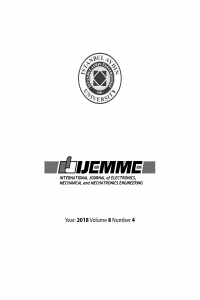Comparison of Equivalent Static Analysis and Mode Combination Method for Concrete Buildings According to Turkish Standard
Abstract
This study aims to define the impact of analysis methods that are used to design buildings and offers their analysis. As
a matter of fact, there are several methods for fundamental analysis of buildings and other civil engineering structures under seismic
situations. Both can be differentiated in the shape of the seismic involvement and in the structure idealization. There are two
measures to identify seismic design forces: one is the equivalent static force, and the other is dynamic analysis which can be in
many forms. One of these forms is the superposition mode. This research aims to study the impact of these methods in the analysis
of a six story concrete building; both results, obtained from the static and dynamic, will be ultimately compared. The results show
that in a MDOF system, such as with six floors or more, the dynamic analysis will lead to displacements and smaller forces
compared with the static process.
References
- [1]https://www.engineeringexamples.net/structural-analysis-procedures-calculate-equivalent-static-force-actingstructure- due-earthquake-loading/ (last visit, 23.04.2019)
- [2] S. H. Helou and Ibrahim Muhammad, Equivalent Lateral Load Method vs. Response Spectrum Analysis Which Way is Forward, Asian Journal of Engineering and Technology,02(05), 2014
- [3] A. Gottala, K. Kishore, s. Yajdhani, Comparative Study of Static and Dynamic Seismic Analysis of a Multistoried Building, IJSTE - International Journal of Science Technology & Engineering, 2(01)2015.
- [4] https://deprem.afad.gov.tr/deprem-tehlike-haritasi (last visit, 23.04.2019)
- [5] N. s. Armouti. Earthquake engineering theory and implementation. Amman. Jordan first edition
- [6] Turkish building code (TBDY), Ankara, Turkey, 2018,
- [7] American Society of Civil Engineers, "Minimum Design Loads for Buildings and Other Structures, ASCE/SEI 7- 10", Reston, VA, 2010
- [8] American Concrete Institute, " Building Code Requirements for Structural Concrete, ACI 318-08 and Commentary", Farmington Hills, Mi, 2008
- [9] International Code Council, "International Building Code, IBC 2009 ", Washington, D.C. 2009
- [10] James K. Wight and James G. McGregor, “Reinforced Concrete Mechanics and Design”, Fifth edition, Pearson International Edition, 2009.
- [11] A. A. Kasimzade, S. Tuhta, G. Atmaca, I. Alameri, O. Abrar, Novel Approach on Performance-Based Aseismic Design Based on FEMA Requirements, International Journal of Trend in Scientific Research and Development (IJTSRD), 3(1), 2018.
- [12] S. Tuhta, I. Alameri, F. Gunday, Numerical algorithms n4sid for system identification of buildings, International Journal of Advanced Research in Engineering Technology & Science, 6(1), 2019.
Details
| Primary Language | English |
|---|---|
| Subjects | Engineering |
| Journal Section | Articles |
| Authors | |
| Publication Date | October 1, 2018 |
| Published in Issue | Year 2018 Volume: 8 Issue: 4 |

